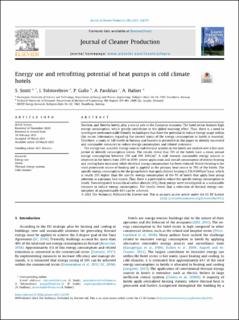| dc.contributor.author | Smitt, Silje Marie | |
| dc.contributor.author | Tolstorebrov, Ignat | |
| dc.contributor.author | Gullo, Paride | |
| dc.contributor.author | Pardiñas, Ángel Á. | |
| dc.contributor.author | Hafner, Armin | |
| dc.date.accessioned | 2021-04-14T12:06:20Z | |
| dc.date.available | 2021-04-14T12:06:20Z | |
| dc.date.created | 2021-04-12T08:55:33Z | |
| dc.date.issued | 2021 | |
| dc.identifier.citation | Journal of Cleaner Production. 2021, 298, . | en_US |
| dc.identifier.issn | 0959-6526 | |
| dc.identifier.uri | https://hdl.handle.net/11250/2737745 | |
| dc.description.abstract | Tourism, and thereby hotels, play a crucial role in the European economy. The hotel sector features high energy consumption, which greatly contributes to the global warming effect. Thus, there is a need to investigate environmentally friendly technologies that have the potential to reduce energy usage within this sector. Information regarding the current status of the energy consumption in hotels is essential. Therefore, a study of 140 hotels in Norway and Sweden is presented in this paper to identify successful and sustainable measures to reduce energy consumption and related emissions. The energy use, available energy sources and thermal systems in the hotels are studied over a five-year period to identify consumption trends. The results reveal that 70% of the hotels have a mean annual energy consumption between 150 and 250 kWh/m2. A shift towards sustainable energy sources is observed in the hotels from 2015 to 2019, where application and overall consumption of district heating and cooling have increased, while electrical energy consumption has been reduced. District heating is the most prominent source of heating and is applied as the primary heat source in 70% of the hotels. The specific energy consumption for the group hotels that apply district heating is 218.9 kWh/m2/year, which is nearly 25% higher than the specific energy consumption of the 9% of hotels that apply heat pump solutions as a primary heat source. Thus, there is a potential to reduce the specific energy consumption in hotels. Two integrated transcritical carbon dioxide (CO2) heat pumps were investigated as a sustainable measure to reduce energy consumption. The results reveal that a reduction of thermal energy consumption of approximately 60% can be achieved. © 2021 The Author(s) | en_US |
| dc.language.iso | eng | en_US |
| dc.publisher | Elsevier Science | en_US |
| dc.rights | Navngivelse 4.0 Internasjonal | * |
| dc.rights.uri | http://creativecommons.org/licenses/by/4.0/deed.no | * |
| dc.title | Energy use and retrofitting potential of heat pumps in cold climate hotels | en_US |
| dc.type | Peer reviewed | en_US |
| dc.type | Journal article | en_US |
| dc.description.version | publishedVersion | en_US |
| dc.source.volume | 298 | en_US |
| dc.source.journal | Journal of Cleaner Production | en_US |
| dc.identifier.doi | 10.1016/j.jclepro.2021.126799 | |
| dc.identifier.cristin | 1903443 | |
| dc.description.localcode | This is an open access article distributed under the terms of the Creative Commons CC-BY license, which permits unrestricted use, distribution, and reproduction in any medium, provided the original work is properly cited. | en_US |
| cristin.ispublished | true | |
| cristin.fulltext | original | |
| cristin.qualitycode | 2 | |

